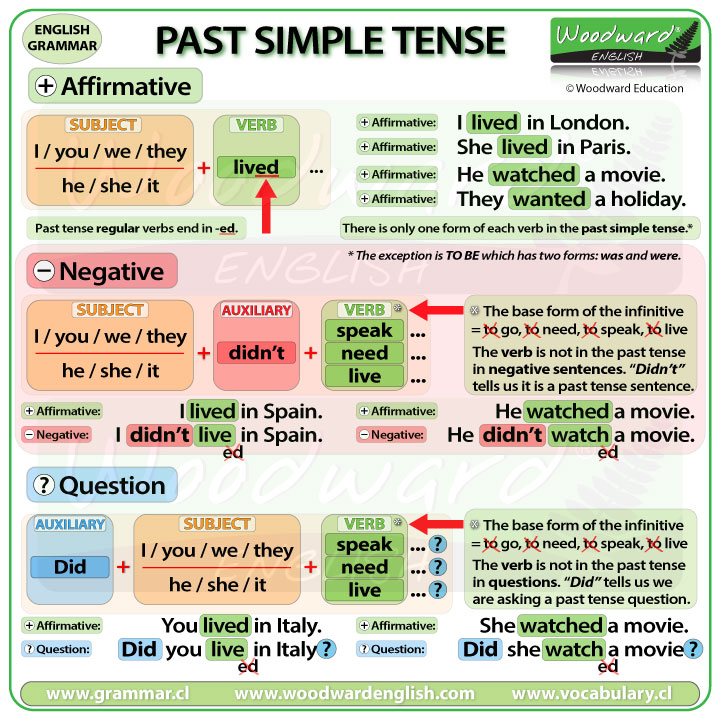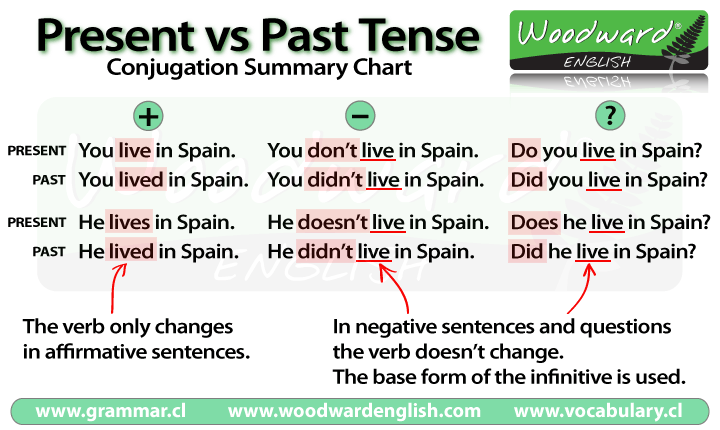Past Tense in English
English Grammar
The Past Simple Tense (also known as Simple Past Tense) is often just called the Past Tense.
If you already know how to use the Present Tense, then the Past Tense will be easy.
In general, the Past Tense is used to talk about something that started and finished at a definite time in the past.
How to form the Past Tense in English
The main rule is that for every verb in English, there is only one form of it in the past tense.
(The exception is the Past tense of To Be, which has two forms: was and were)
This is totally different from other languages such as Spanish, French, Italian etc. where you change the verb ending for every subject.
For example: The past tense of the verb want is wanted.
Wanted is used as the past tense for all subjects/pronouns.
- I wanted
- You wanted
- He wanted
- She wanted
- It wanted
- We wanted
- They wanted
So you just have to learn one word to be able to use it in the past tense. In this case we just needed to learn the one word wanted which can be used for all subjects (or people).
Past Tense Regular Verbs
To change a regular verb into its past tense form, we normally add –ED to the end of the verb.
- play – played
- cook – cooked
- rain – rained
- wait – waited
There are some exceptions with a slight change in spelling which you can see here:
Spelling of words ending in ED.
Examples of sentences using regular verbs in the past tense
- Last night I played my guitar loudly and the neighbors complained.
- She kissed me on the cheek.
- It rained yesterday.
- Angela watched TV all night.
- John wanted to go to the museum.
Note: There are three different ways of pronouncing the –ed at the end of a verb in the past tense.
We recommend reading our guide about the pronunciation of –ED at the end of words.
Negative sentences in the Past Tense
We use didn't (did not) to make a negative sentence in the past tense.
This is for regular AND irregular verbs in English.
(Exception is To Be and Modal Verbs such as Can)
Compare the following:
Present: They don't live in Canada.
Past: They didn't live in Canada.
The main verb (live in the example above) is in its base form (of the infinitive). The auxiliary DIDN'T shows that the sentence is negative AND in the past tense.
NOTICE: The only difference between a negative sentence in the present tense and a negative sentence in the past tense is the change in the auxiliary verb.
Both don't and doesn't in the present tense become didn't in the past tense.
Compare the negative sentences in the examples below:
Present: You don't need a mechanic.
Past: You didn't need a mechanic.
Present: You don't walk to work.
Past: You didn't walk to work.
Present: He doesn't speak Japanese.
Past: He didn't speak Japanese.
Examples of negative sentences in the Past Tense
- I didn't want to go to the dentist.
- She didn't have time.
- You didn't close the door.
- He didn't come to my party.
- They didn't study so they didn't pass the test.
- We didn't sleep well last night.
Questions in the Past Tense
We use did to make a question in the past tense.
This is for regular AND irregular verbs in English.
(Exception is To Be and Modal Verbs such as Can)
Compare the following:
Present: Do they live in France?
Past: Did they live in France?
The main verb (live in the example above) is in its base form (of the infinitive). The auxiliary DID shows that the question is in the past tense.
NOTICE: The only difference between a question in the present tense and a question in the past tense is the change in the auxiliary verb.
Both Do and Does in present tense questions become Didn't in past tense questions.
Compare the questions in the examples below:
Present: Do you need a doctor?
Past: Did you need a doctor?
Present: Do you ride your bike to work?
Past: Did you ride your bike to work?
Present: Does he live in Italy?
Past: Did he live in Italy?
We can also use a question word (Who, What, Why etc.) before DID to ask for more information.
- Did you study? – Yes, I did.
- When did you study? – I studied last night.
- Where did you study? – I studied at the library.
Read more about short answers in the past tense.
Examples of Questions in the Past Tense
- Did you go to work yesterday?
- Did they arrive on time?
- Did she like the surprise?
- Where did she go?
- What did you do yesterday?
- What did you say? - I didn't say anything.
- Why did we have to come?

Irregular Verbs in the Past Tense
Irregular verbs are ONLY irregular in affirmative/positive sentences.
(An exception to this is with the verb TO BE in the Past Tense).
For example: The past tense of GO is WENT.
It does not end in –ED so it is considered irregular.
The word went is used for all subjects – I, you, we, they, he, she, it.
- I went to the beach
- He went to the park.
- She went to the zoo.
- They went to the library.
BUT, as we mentioned before, it is only in its irregular form (went) in sentences that are affirmative/positive.
Compare the following using GO in the past tense.
- They went to the beach
- They didn't go to the beach --- Didn't shows that we are talking in the past tense.
- Did they go to the beach? --- Did shows that we are talking in the past tense.
Another example with an irregular verb.
The past of EAT is ATE.
- You ate my cake.
- You didn't eat my cake.
- Did you eat my cake?
Present vs Past Tense Summary Chart

Next activities
See our other complete English lesson here: Past Simple Tense in English.
Try our game about Past Tense Irregular Verbs.
See our long list of irregular verbs in English.
Read about how to use To Be in the Past tense and about using short answers for questions in the Past Tense.
El Pasado Simple en inglés explicado en español
If you found this English Grammar Guide about the Past Simple Tense in English interesting or useful, let others know about it.
